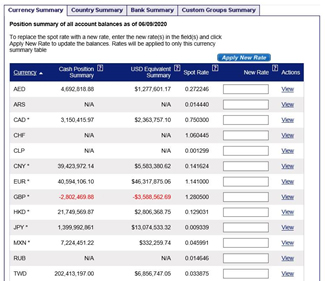
High-yield bond issuance: 5 traits lawyers should look for in a service provider

What you need to know before buying a new or used car

Generally speaking, uncertainty is bad for business. But when there’s a global financial crisis, with all the uncertainty that brings, the challenges multiply for companies engaged in international trade. Two of the biggest challenges are cash flow unpredictability and currency exchange rate volatility.
It’s bad for a domestic business when receivables start slowing down. But it can be even more problematic for companies trading globally that must monitor unpredictable cash flow in multiple currencies.
With the growth of internet-based commerce, an increasing number of companies fit this description. When seeking out best practices for keeping tabs on international cash flow in this environment, we consulted Adam Towers, vice president and group product manager, International Solutions, at U.S. Bank. Here is a strategy he recommends:
Adopt a treasury management system that provides a global cash platform. As cash flows become less predictable, it’s easy for a company that has multiple bank accounts in multiple countries in multiple currencies to become overdrawn in an account or a particular currency. Monitoring for such problems gets easier, however, if the company adopts a global platform that provides a summary view of its cash balances by country, bank and currency (see screenshot below).

With this sort of platform, if you see you are overdrawn in British pounds (GBP), for instance, you can drill down to learn which accounts at which banks are overdrawn, and then effect funds transfers between accounts to alleviate any GBP shortfalls.
Having a single screen where you can go to review all your cash in various currencies gives you more visibility to your company’s cash positions, which enables more effective cash forecasting.
“Today, many middle-market businesses have accounts in multiple regions for buying and selling goods,” Towers says. “A company with five banks using three currencies can really benefit from the visibility and efficiency of that managing all of its cash in one central place.”
During periods of uncertainty, currency exchange rates move unpredictably and often quite sharply. To visualize this market volatility, all you need to do is review a U.S. dollar-to-euro currency exchange rate chart for 2020 and note the dramatic up-and-down movements that began in the first quarter.
For international businesses, extreme foreign exchange rate volatility can have an enormous impact on costs and revenue. For example, if you enter into an agreement to buy raw materials from a German company at a certain price in euros, before the transaction is completed the euro could dramatically appreciate in value against the dollar, making the purchase much more expensive. Similarly, for exporters, big rate swings can eat into profits on sales to foreign customers.
"Having a single screen where you can go to review all your cash in various currencies gives you more visibility to your company’s cash positions, which enables more effective cash forecasting."
Fortunately, companies can take steps to mitigate the risks of market volatility, protect assets, and even stabilize costs amidst a crisis. Here are some strategies U.S. Bank experts recommend:
Consider hedging. Currency hedging products enable companies to secure a guaranteed foreign exchange rate in advance of transactions, whether buying or selling.
The simplest hedging solution is the forward contract, a basic arrangement in which you set a specific date when you will get the currency you need for a price you agree to today.
By selling at a euro-denominated price and entering into a forward contract, a U.S. exporter would forfeit the potential opportunity to earn an extra profit if the euro appreciated against the dollar between the time the exporter set the price and when it shipped the goods. Yet the exporter also eliminates the possibility of losing out if currency markets move in the opposite direction.
Similarly, using a forward contract, a U.S. importer that agrees to pay a supplier in euros knows today what the dollar cost of those euros will be when the time comes to pay the supplier.
“Hedging is not about making a bet that the market will go up or down,” explains Chris Braun, managing director and head of FX Sales at U.S. Bank. “It’s about taking the volatility out of the market and creating certainty.”
Companies can use a wide variety of other foreign exchange tools — including foreign currency option contracts — to address exchange rate uncertainty. With all the available choices, some treasurers shy away from FX hedging because it seems too complex. However, hedging need not be feared. The FX sales representative at your bank can help you evaluate if hedging makes sense for your company, and if it does, suggest the right tools and strategies to meet your objectives.
Ask your foreign suppliers to invoice you in U.S. dollars (USD) and their local currency. By asking for prices in both USD and its supplier’s local currency, an importer can assess the most cost-effective choice.
Typically, the USD price will be more, because a USD payment would require a foreign supplier to do the currency conversion and manage the foreign exchange. However, an importer might decide it’s worthwhile to pay a little more in order to avoid having to manage the FX risk. “Giving yourself that flexibility can be really powerful,” Towers says.
Here’s a final and critically important recommendation:
Consult with the international specialists at your bank. When addressing the uncertainty of a financial crisis, companies engaged in international business should consult with knowledgeable treasury management and foreign exchange banking professionals.
With regulations that vary from country to country, multiple currencies to manage, and processes that are vastly different from domestic trade, international trade is a complex, fast-moving arena. “As a result,” Towers says, “whether you need to explore hedging your exposure to foreign currencies, negotiate terms with a trading partner or choose the right treasury management system, it always makes sense to talk to the international experts at your bank.”
It may seem intimidating to pay or invoice in foreign currency, but our goal is to make it easy for you. Contact your banking partner to learn more about foreign exchange services and FX risk mitigation. Your partners can help find the right services to fit your needs.


